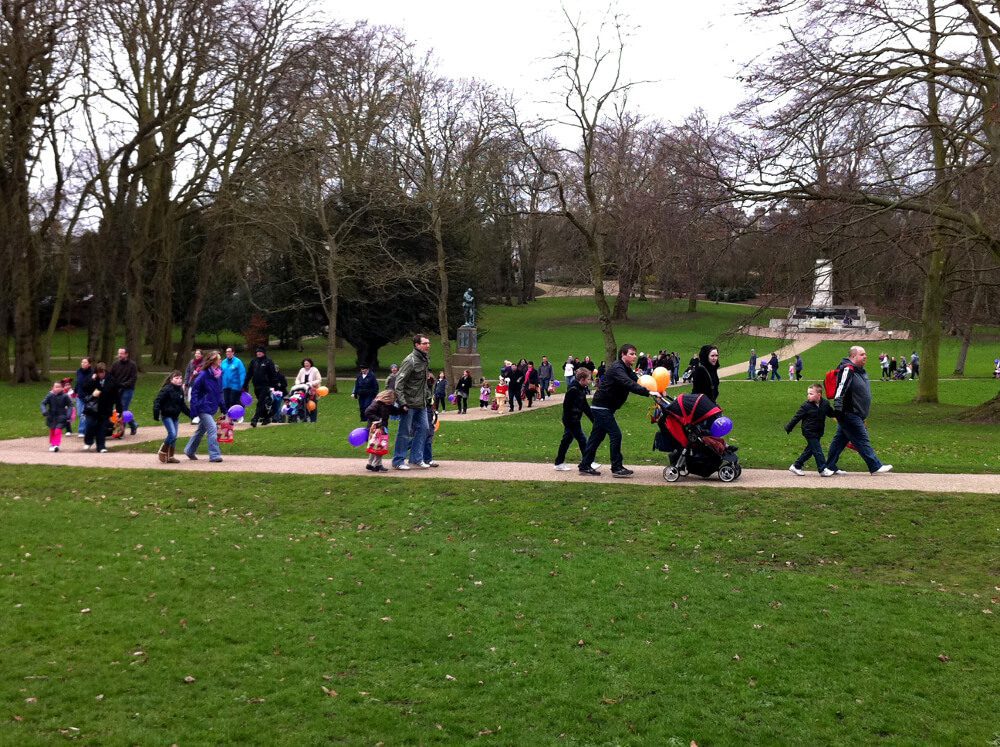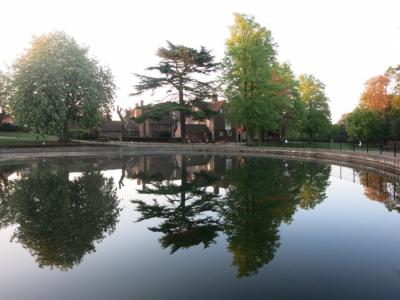Christchurch Park is essentially rectangular in shape and covers an area of 33 hectares (approximately 82 acres) in the centre of Ipswich. The parkland falls about 38 metres from Park Road in the north tapering at the southern end where it meets Soane Street. The topography in the central section is pronounced, with many steep undulations providing tangible evidence of 19th-century gravel extraction.
The Park is an urban green space where centuries of planting and parkland development have produced a varied landscape which today has many mature trees in groups or peppering managed park grassland, whilst around the Mansion, more formal lawns and small garden areas are maintained. the Park can be divided into five Landscape Character Areas: Mansion & War Memorial Area, Parkland, Wildlife Valley, Lower Arboretum and Upper Arboretum.
Most of the main Park is traditional open parkland. Here the grass is maintained for informal recreational purposes and large mature trees dominate the landscape (apart from the west-facing slopes of Snow Hill where there is little tree cover). A notable grassland presence is the Bee Wolf, a Red Data List species classed as vulnerable, which has colonies on the warm baked south-facing short grass slope near the Bolton Lane entrance and further north near the Pavilion Cafe.
Some of the oldest trees in the Park, the pollarded Sweet Chestnuts and Oaks that stand alongside the central avenue, are three to four hundred years old. These veteran trees support important communities of birds and invertebrates because of the standing dead wood in various states of decay with the resultant hollows, holes and sap runs. Allowing the grass to grow taller in certain areas by reducing mowing has been effective in developing associated animals and invertebrates. Grassland butterflies such as the Meadow Brown, Gatekeeper, and the Wall Brown have recolonised, along with Grasshoppers and the Dark Bush Cricket. There are numerous small mammal holes and burrows but species remain unidentified. Foxes are known to live in this area.
The Wildlife Valley runs from north to south in the centre of the Park. At the southern end there is the Wildlife Reserve and the Wilderness, Medieval and Bog ponds. The ponds together with the various flushes, seepages and springlines are important foraging points for waterfowl and because the flushes have been present for hundreds and probably thousands of years they have developed important invertebrate and microflora communities. The two larger ponds are full of small fish that in turn support a number of higher predators including Brown Rats, Kingfishers and Red-eared Slider Terrapin. There are large numbers of Mallard, Mandarin Duck and Canada Geese present and at least three bat species including Daubenton’s, Noctule and Pipistrelle. The Bog Pond has a limited marginal flora of Water Iris, Great Willowherb and Creeping Buttercup, Lady’s Smock, and Brooklime in its overflow areas.
The Wildlife Reserve is a mature mixed woodland with a clearly defined character as a wildlife area. As you travel north, woodland gives way first to wet then dry meadows. Notable breeding successes in the Reserve include the recolonisation by the Speckled Wood Butterfly and higher predators such as Tawny Owl and Sparrowhawk. Other notable birds include Nuthatches and Treecreepers, and both Green and Great-Spotted Woodpeckers breed here. In the open woodland edge you will find ground flora of Ivy with Bramble, Common Nettle, Yorkshire Fog, Cocksfoot and False Oat-grass. Where the Scots Pine is at its thickest, there is a limited understorey of Elder, Spindle, Rhododendron and Honeysuckle and sparse ground flora of Cow Parsley, Common Nettle, Lesser Celandine and Lords-and-Ladies. The more open woodland edge consists of Hazel, Elder, Sycamore and Horse Chestnut, Bramble, Common Nettle, Yorkshire Fog, Cocksfoot and False Oat-grass with Daffodils planted in the woodland glade.
The fenced Wet Meadow is about 60-70% Common Nettle. Other notables include Lesser Celandine, Yellow Loosestrife, Snakeshead Fritillary (which provide a fine display in the spring), Lady’s Smock, Broadleaved Dock, Meadowsweet and Yorkshire Fog. Watercress and Great Willowherb dominate the stream while the lower areas of the valley are dominated by Creeping Buttercup and Yorkshire Fog. The wet meadows grade into the drier higher meadows of Common Bent, Red Fescue, Ribwort Plantain, Ryegrass, Yarrow, Sheep’s Sorrel and Common Sorrel.


